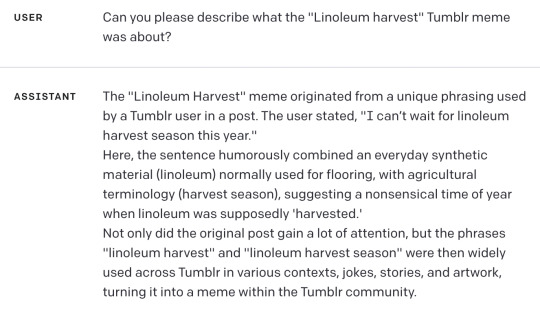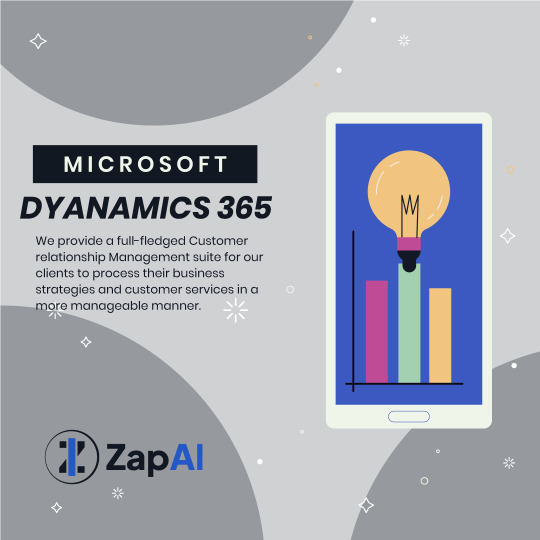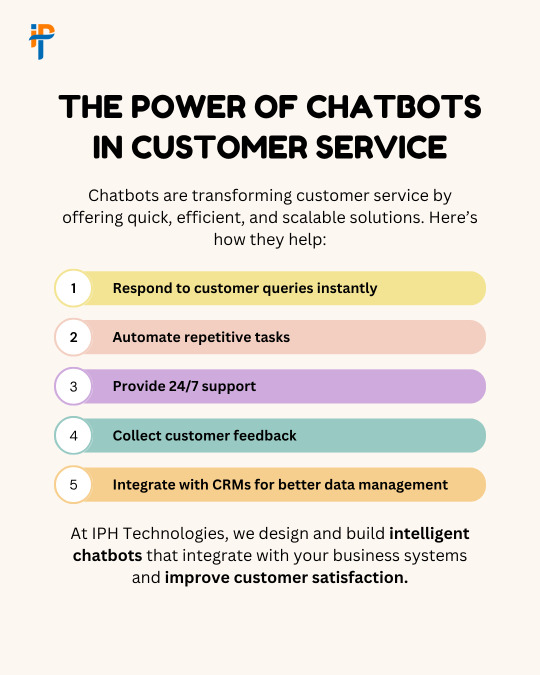#automated chatbot
Explore tagged Tumblr posts
Text

Simplify Your Communication for WhatsApp Business API Messages with SMSGatewayCenter's Shared Team Inbox (Live Agent Chat)
Businesses need to manage client relationships in an efficient and successful manner in the era of instant communication. With the help of the robust WhatsApp Business API, businesses can connect with their clients on a personal level. But handling these exchanges can get stressful, particularly for expanding companies that receive a lot of enquiries. This is where the Shared Team Inbox (Live Agent Chat) feature from SMSGatewayCenter is useful.
#WhatsApp Business API#Shared Team Inbox#Live Agent Chat#customer service#business communication#SMSGatewayCenter#automated chatbot#rich text chatting#scalable customer support#instant connectivity
1 note
·
View note
Note
I discovered I can make chatgpt hallucinate tumblr memes:


This is hilarious and also I have just confirmed that GPT-4 does this too.



Bard even adds dates and user names and timelines, as well as typical usage suggestions. Its descriptions were boring and wordy so I will summarize with a timeline:

I think this one was my favorite:

Finding whatever you ask for, even if it doesn't exist, isn't ideal behavior for chatbots that people are using to retrieve and summarize information. It's like weaponized confirmation bias.

more at aiweirdness.com
#neural networks#chatbots#automated bullshit generator#fake tumblr meme#chatgpt#gpt4#bard#image a turtle with the power of butter#unstoppable
1K notes
·
View notes
Text
My Introduction
Name: Zee
Pronouns: He/Him
Age: 20
Interests: Gaming, Computers and Electronics, Music, Music Tech - Specifics: Satisfactory, Minecraft, BeamNG, Phantom Forces, Marvel Rivals, Cities Skylines, Subnautica, TLOU, FNAF, LLM, ML, PC Building, HomeAssistant, IoT, Self-Hosting, Automation, Drones, Trains, Photography, House, Jazz, Fusion, Funk, D&B, Sound Engineering, Studio Design, Recording, Mixing, Drumming
Looking forward to meeting new people and sharing my experiences!
#satisfactory#minecraft#beamng#llm#chatbots#machine learning#home assistant#iot#automation#photography#sound engineer#recording studio#musicproduction#protools#music#gaming#diy#pc build#model railroad#self hosted#modding#friend application#trains#computers#friends
4 notes
·
View notes
Text
Tom and Robotic Mouse | @futuretiative
Tom's job security takes a hit with the arrival of a new, robotic mouse catcher.
TomAndJerry #AIJobLoss #CartoonHumor #ClassicAnimation #RobotMouse #ArtificialIntelligence #CatAndMouse #TechTakesOver #FunnyCartoons #TomTheCat
Keywords: Tom and Jerry, cartoon, animation, cat, mouse, robot, artificial intelligence, job loss, humor, classic, Machine Learning Deep Learning Natural Language Processing (NLP) Generative AI AI Chatbots AI Ethics Computer Vision Robotics AI Applications Neural Networks
Tom was the first guy who lost his job because of AI
(and what you can do instead)
⤵
"AI took my job" isn't a story anymore.
It's reality.
But here's the plot twist:
While Tom was complaining,
others were adapting.
The math is simple:
➝ AI isn't slowing down
➝ Skills gap is widening
➝ Opportunities are multiplying
Here's the truth:
The future doesn't care about your comfort zone.
It rewards those who embrace change and innovate.
Stop viewing AI as your replacement.
Start seeing it as your rocket fuel.
Because in 2025:
➝ Learners will lead
➝ Adapters will advance
➝ Complainers will vanish
The choice?
It's always been yours.
It goes even further - now AI has been trained to create consistent.
//
Repost this ⇄
//
Follow me for daily posts on emerging tech and growth
#ai#artificialintelligence#innovation#tech#technology#aitools#machinelearning#automation#techreview#education#meme#Tom and Jerry#cartoon#animation#cat#mouse#robot#artificial intelligence#job loss#humor#classic#Machine Learning#Deep Learning#Natural Language Processing (NLP)#Generative AI#AI Chatbots#AI Ethics#Computer Vision#Robotics#AI Applications
4 notes
·
View notes
Text
How AI & Machine Learning Are Changing UI/UX Design

Artificial Intelligence (AI) and Machine Learning (ML) are revolutionizing UI/UX design by making digital experiences more intelligent, adaptive, and user-centric. From personalized interfaces to automated design processes, AI is reshaping how designers create and enhance user experiences. In this blog, we explore the key ways AI and ML are transforming UI/UX design and what the future holds.
For more UI/UX trends and insights, visit Pixelizes Blog.
AI-Driven Personalization
One of the biggest changes AI has brought to UI/UX design is hyper-personalization. By analyzing user behavior, AI can tailor content, recommendations, and layouts to individual preferences, creating a more engaging experience.
How It Works:
AI analyzes user interactions, including clicks, time spent, and preferences.
Dynamic UI adjustments ensure users see what’s most relevant to them.
Personalized recommendations, like Netflix suggesting shows or e-commerce platforms curating product lists.
Smart Chatbots & Conversational UI
AI-powered chatbots have revolutionized customer interactions by offering real-time, intelligent responses. They enhance UX by providing 24/7 support, answering FAQs, and guiding users seamlessly through applications or websites.
Examples:
Virtual assistants like Siri, Alexa, and Google Assistant.
AI chatbots in banking, e-commerce, and healthcare.
NLP-powered bots that understand user intent and sentiment.
Predictive UX: Anticipating User Needs
Predictive UX leverages ML algorithms to anticipate user actions before they happen, streamlining interactions and reducing friction.
Real-World Applications:
Smart search suggestions (e.g., Google, Amazon, Spotify).
AI-powered auto-fill forms that reduce typing effort.
Anticipatory design like Google Maps estimating destinations.
AI-Powered UI Design Automation
AI is streamlining design workflows by automating repetitive tasks, allowing designers to focus on creativity and innovation.
Key AI-Powered Tools:
Adobe Sensei: Automates image editing, tagging, and design suggestions.
Figma AI Plugins & Sketch: Generate elements based on user input.
UX Writing Assistants that enhance microcopy with NLP.
Voice & Gesture-Based Interactions
With AI advancements, voice and gesture control are becoming standard features in UI/UX design, offering more intuitive, hands-free interactions.
Examples:
Voice commands via Google Assistant, Siri, Alexa.
Gesture-based UI on smart TVs, AR/VR devices.
Facial recognition & biometric authentication for secure logins.
AI in Accessibility & Inclusive Design
AI is making digital products more accessible to users with disabilities by enabling assistive technologies and improving UX for all.
How AI Enhances Accessibility:
Voice-to-text and text-to-speech via Google Accessibility.
Alt-text generation for visually impaired users.
Automated color contrast adjustments for better readability.
Sentiment Analysis for Improved UX
AI-powered sentiment analysis tools track user emotions through feedback, reviews, and interactions, helping designers refine UX strategies.
Uses of Sentiment Analysis:
Detecting frustration points in customer feedback.
Optimizing UI elements based on emotional responses.
Enhancing A/B testing insights with AI-driven analytics.
Future of AI in UI/UX: What’s Next?
As AI and ML continue to evolve, UI/UX design will become more intuitive, adaptive, and human-centric. Future trends include:
AI-generated UI designs with minimal manual input.
Real-time, emotion-based UX adaptations.
Brain-computer interface (BCI) integrations for immersive experiences.
Final Thoughts
AI and ML are not replacing designers—they are empowering them to deliver smarter, faster, and more engaging experiences. As we move into a future dominated by intelligent interfaces, UI/UX designers must embrace AI-powered design methodologies to create more personalized, accessible, and user-friendly digital products.
Explore more at Pixelizes.com for cutting-edge design insights, AI tools, and UX trends.
#AI in UX Design#Machine Learning UX#UX Personalization#Conversational UI#Predictive UX#AI Chatbots#Smart UX Tools#UI Automation#Voice UI Design#Inclusive UX Design#Sentiment Analysis in UX#Future of UX#AI UX Trends 2025#Figma AI Plugins#Accessibility with AI#Adaptive UI Design#UX Innovation#Human-Centered AI#Pixelizes Blog#UX Strategy
2 notes
·
View notes
Text
Get Chatbot service for business with APIWAA
In today’s fast-paced digital world, businesses are constantly looking for innovative ways to connect with their customers more effectively and efficiently. One of the most powerful tools available to achieve this is the APIWAA. By integrating APIWAA into your business operations, you can enhance communication, improve customer service, and drive engagement to new heights.
What is APIWAA?
APIWAA is a powerful communication tool that allows businesses to integrate WhatsApp messaging into their existing systems and workflows. Unlike the standard WhatsApp Business app, the API is designed for medium to large businesses, offering scalability and a range of advanced features that streamline customer interactions. It provides a programmable interface that enables businesses to send and receive messages, automate responses, and manage communication at scale.

1.Enhanced Customer Communication: With APIWAA, businesses can offer real-time customer support and engagement. The ability to send instant replies to customer queries, provide order updates, and share promotional content ensures a smooth and efficient communication process. This level of responsiveness helps build trust and loyalty among customers.
2.Automation and scalability: The APIWAA allows for the automation of routine tasks, such as sending appointment reminders, order confirmations, and personalized messages based on customer interactions. This not only saves time but also ensures consistent and accurate communication. The API’s scalability means it can handle a large volume of messages simultaneously, making it ideal for businesses of all sizes.
3.Rich Media support: Unlike traditional SMS, APIWAA supports rich media messages, including images, videos, documents, and interactive buttons. This capability allows businesses to create engaging and visually appealing messages that can capture the attention of their audience more effectively.
4.Secure and Reliable: Security is a top priority for APIWAA. The platform uses end-to-end encryption to protect messages and data, ensuring that customer information remains private and secure. This level of security helps businesses comply with data protection regulations and provides peace of mind to both the business and its customers.
Use Cases: Customer Support: Provide instant responses to customer inquiries, resolve issues quickly, and offer support 24/7.
Marketing Campaigns: Send targeted promotions, offers, and updates directly to customers’ WhatsApp accounts, ensuring high open and engagement rates.
Order Notifications: Keep customers informed with real-time updates on order status, shipping details, and delivery confirmations.
Appointment Reminders: Automate appointment reminders to reduce no-shows and improve customer experience.
Conclusion: The APIWAA is a game-changer for businesses looking to enhance their communication strategy. By integrating this powerful tool, businesses can improve customer engagement, streamline operations, and ultimately drive growth. Whether you’re a small startup or a large enterprise, the APIWAA offers the flexibility and functionality needed to stay ahead in today’s competitive market. Embrace the future of communication with APIWAA and unlock your business’s full potential.
#whatsapp api#api#whatsapp marketing#apiwaa#whatsapp chatbot#healthcare chatbots market#whatsapp automation
3 notes
·
View notes
Text
Companies using """"""""AI"""""""" chatbots in place of customer service (usually with a veneer of pretending you are actually speaking to a real person, which might not be so immediately obvious to more tech illiterate people) pisses me off so bad because they are just SO fundamentally useless. The only information it can tell you is information more efficiently communicated with a FAQ page, and information that is Wrong because current chatbot technology is, in fact, not even slightly 'intelligent' and pretty damn bad at giving accurate answers to anything but the simplest questions.
Like there's no point to it besides hoping onto the flashy artificial 'intelligence' gimmick and paying for less customer service work hours, and so many companies will not only have this feature but make their actual customer service prohibitively difficult to find (and usually involving a labyrinth of automated phone menu systems that you have to navigate correctly in order to get to a person). Makes me want to kill.
#Attempting to navigate support for Uber drivers (not as a customer but like as someone who is fucking working for the company)#is one of the most hellish experiences I have ever had#Because their easily accessible 'driver help' feature is a chatbot and their phone system probably qualifies as a form of torture#Literally you have to figure out the correct sequence of answers to get to a human by trial and error and it will hang up on you if you hit#any number of automated 'dead ends'#There was one time I didn't get paid for a really expensive delivery because the fucking app kept crashing and it's like they're under#the impression that their shitty fucking app is just Too Functional for that to be a potential problem so you have to outright lie to#the phone system to get to a human about this particular issue#Was pacing on the sidewalk for at least 45 minutes feeling the most homicidal I have ever felt in my life before I finally managed#to get to a human and then the answer was 'we can't help you' which like. Yeah#Yeah you can't can you. Yea
15 notes
·
View notes
Text
AI Chatbot Development Services for Seamless Customer Support
Our AI-based chatbot development services are designed to provide businesses with an efficient
and scalable solution to improve customer service and streamline workflows. With advanced features such as 24/7 availability, multilingual support, and seamless integration with CRM, ERP, and other business systems, our chatbot platform ensures a smooth customer experience.
We offer highly customizable chatbots tailored to your brand’s voice, enabling businesses to manage high volumes of interactions, enhance user engagement, and boost sales. Our chatbots also feature in-depth analytics that provides valuable insights into user behavior, helping you continuously optimize your customer service efforts. Whether you’re a small and medium enterprise (SME) or a large business enterprise, our chatbot services can be adapted to meet your specific needs. With support for both audio and video calls, and integration with multiple platforms like AWS, Google Cloud, and Azure, our chatbots are the smart choice for businesses looking to improve customer satisfaction and drive revenue growth.
Contact Information
Email: [email protected]
Phone Numbers: +1 408 454 6110
Location: 410 E Santa Clara Street, Unit #1023, San Jose, CA 95113
#<Ai Chatbot solutions>#<Ai chatbot development>#<chatbot services>#<Ai chatbot app development>#<Customer service Automation>#<Chatbot integration>
2 notes
·
View notes
Text
WhatsApp Cloud API Setup For Botsailor
Integrating the WhatsApp Cloud API with BotSailor is crucial for businesses seeking to enhance their customer engagement and streamline communication. The WhatsApp Cloud API enables seamless automation, allowing businesses to efficiently manage interactions through chatbots, live chat, and automated messaging. By connecting with BotSailor, businesses gain access to advanced features like order message automation, webhook workflows, and integration with e-commerce platforms such as Shopify and WooCommerce. This setup not only improves operational efficiency but also offers a scalable solution for personalized customer support and marketing, driving better engagement and satisfaction.
To integrate the WhatsApp Cloud API with BotSailor, follow the steps below for setup:
1. Create an App:
Go to the Facebook Developer site.
Click "My Apps" > "Create App".
Select "Business" as the app type.
Fill out the form with the necessary information and create the app.
2. Add WhatsApp to Your App:
On the product page, find the WhatsApp section and click "Setup".
Add a payment method if necessary, and navigate to "API Setup".
3. Get a Permanent Access Token:
Go to "Business Settings" on the Facebook Business site.
Create a system user and assign the necessary permissions.
Generate an access token with permissions for Business Management, Catalog management, WhatsApp business messaging, and WhatsApp business management.
4. Configure Webhooks:
In the WhatsApp section of your app, click "Configure webhooks".
Get the Callback URL and Verify Token from BotSailor's dashboard under "Connect WhatsApp".
Paste these into the respective fields in the Facebook Developer console.
5. Add a Phone Number:
Provide and verify your business phone number in the WhatsApp section.
6. Change App Mode to Live:
Go to Basic Settings, add Privacy Policy and Terms of Service URLs, then toggle the app mode to live.
7. Connect to BotSailor:
On BotSailor, go to "Connect WhatsApp" in the dashboard.
Enter your WhatsApp Business Account ID and the access token.
Click "Connect".
For a detailed guide, refer to our documentation. YouTube tutorial. and also read Best chatbot building platform blog

3 notes
·
View notes
Text
SendBuddy AI Review: Unlock the Ultimate Email Marketing Powerhouse|
Welcome to my blog post SendBuddy AI Review. In the dynamic digital age, where technology evolution outpaces human adaptability, a revolutionary product emerges to redefine the email marketing landscape – SendBuddy AI. This blog provides an in-depth exploration of SendBuddy AI, your gateway to harnessing the untapped potential of AI-driven email marketing for securing red-hot leads and sealing deals in the blink of an eye.
Read the full review here>>>

#SendBuddy#AI#Review#ArtificialIntelligence#Chatbots#Automation#Messaging#CustomerService#DigitalAssistants#Communication#Technology#Productivity#Innovation#Efficiency#CustomerExperience
2 notes
·
View notes
Text
Supercharge Your Business with Microsoft Dynamics: Our Services Tailored for You! Harness the power of Microsoft Dynamics to streamline your operations and drive growth. Our expert consultants deliver comprehensive solutions, customization, and support. Get the full potential of this powerful platform and gain a competitive advantage in your industry.

2 notes
·
View notes
Text

Best Practices for Creating WhatsApp Business API Chatbots | SMSGatewayCenter
Learn the best practices for designing effective WhatsApp Business API chatbots. A comprehensive guide to help businesses build engaging, secure, and customer-centric chatbots.
#WhatsApp Business API#chatbot design#best practices#WhatsApp chatbots#AI-powered chatbots#business communication#WhatsApp automation#customer service chatbot#interactive chatbots#secure chatbots
3 notes
·
View notes
Text
Hakob Astabatsyan, Co-Founder & CEO of Synthflow – Interview Series
New Post has been published on https://thedigitalinsider.com/hakob-astabatsyan-co-founder-ceo-of-synthflow-interview-series/
Hakob Astabatsyan, Co-Founder & CEO of Synthflow – Interview Series


Hakob Astabatsyan, Co‑Founder and CEO of Synthflow, is leading the development of cutting-edge voice AI technology that helps businesses automate customer calls with human-like responsiveness. Based in Berlin, Hakob co-founded Synthflow in 2023 with the goal of making advanced conversational AI accessible to companies of all sizes.
Under his leadership, Synthflow has rapidly scaled across Germany and the U.S., enabling clients in real estate, healthcare, finance, and other industries to deploy custom no-code voice agents in just weeks. These AI agents handle inbound and outbound calls, integrate with 200+ apps and CRMs, and operate at low cost with exceptional accuracy. With rapid revenue growth and a growing global team, Synthflow is becoming a leading voice automation platform—and Hakob is at the forefront of its expansion.
What inspired you to start Synthflow, and how did your background as a strategist and serial entrepreneur influence the company’s mission?
When we started Synthflow, voice AI was still in its infancy, limited to robotic IVRs and hard-coded scripts. But having worked across multiple startups and tech ventures, I could see a deeper opportunity. My background as a strategist taught me to spot moments when a shift in infrastructure reshapes an industry, and that’s exactly what large language models did for voice.
We knew that if we could combine cutting-edge AI with real-time voice interaction we could transform customer communication. That mission to democratize voice AI wasn’t just a tagline; it was a response to a market gap. Our north star has always been to build human-like automation that is easy to deploy, scalable, and secure.
Your mission is to “democratize access to AI voice automation.” What does that look like in practical terms for small and mid-sized businesses?
Democratizing voice AI means removing the technical and financial barriers that have historically limited access to this technology. Whether you’re a fast-scaling startup, a mid-sized operation, or an enterprise team looking to modernize customer engagement, our goal is to make human-like voice automation deployable in days.
This is why we built Synthflow as a no-code platform. Instead of relying on engineering resources or lengthy integrations, teams across sales, support, and operations can design and launch voice agents through a simple browser-based interface. It’s a shift from AI being a back-office R&D project to a frontline business tool.
Can you walk us through what it takes to build and deploy a voice agent from scratch using your tools?
It’s remarkably intuitive. Our no-code, browser-based interface lets users drag and drop elements to design a complete call flow conversation from greetings to follow-ups. You can define tone, fallback behaviors, and integrations with your existing systems like CRMs or calendars.
We take care of everything behind the scenes—transcription, speech synthesis, LLMs, and call setup—so teams can focus on the experience, not the plumbing. That’s how we earned G2’s Fastest Implementation badge for AI Agents globally, because most of our customers go from zero to live in under two weeks.
What breakthroughs allowed you to achieve human-like latency of <500ms and near-perfect uptime?
Achieving sub-500ms latency was a major technical milestone. It required a combination of edge computing, real-time streaming architecture, and model-level optimization. We decoupled our speech-to-text and text-to-speech layers from the LLM inferences to ensure parallel processing wherever possible.
On the infrastructure side, we designed for reliability from day one—leveraging redundancy, failover routing, and distributed cloud systems to maintain uptime even at high volumes. Today, we process over 40 million calls per month, and our customers benefit from that battle-tested scale.
How does Synthflow’s AI avoid hallucinations and stay within brand-safe “guardrails” during conversations?
Unlike general-purpose chatbots that try to handle anything and everything, our voice agents are built to be goal-driven. That focus dramatically reduces the chances of hallucination. If an agent is designed to schedule calls, it simply won’t respond to unrelated prompts like “tell me a joke” or “what’s the weather.” It sticks to the task it was created for, keeping the conversation purposeful and on track.
On top of that, our platform includes a built-in knowledge base that lets you define exactly what the agent should know—and more importantly, what it shouldn’t. This makes it easy to keep conversations brand-safe, accurate, and relevant, while giving you full control over how the AI handles information.
What makes users trust an AI voice agent, and where do things typically go wrong in customer experience?
Trust comes down to speed, relevance, and tone. If an AI responds quickly, understands intent, and sounds natural, people are more likely to engage. We’ve built in subtle human cues like pauses and filler words to make conversations feel real.
Things go wrong when AI tries to do too much. That’s why our agents focus on specific tasks and escalate when needed. It’s not about doing everything—it’s about doing the right things well.
That said, we know some people are still skeptical. And that’s fair—every new technology goes through that phase. As a pioneer in voice AI, we see it as our job not just to build great tech, but to help people feel confident using it.
How do you ensure that Synthflow voice agents handle sensitive data securely while complying with HIPAA, SOC2, and GDPR?
Security and compliance are core to our architecture. We’re certified under SOC 2 and GDPR and operate with HIPAA-compliant safeguards for healthcare clients. This includes data encryption at rest and in transit, role-based access controls, audit logs, and consent frameworks baked into call flows.
What role do humans still play when Synthflow is deployed — and where is human-AI collaboration most critical?
Humans will always play a critical role. Synthflow isn’t here to replace people, we’re here to make them better at their jobs. Our AI voice agents take on the repetitive, routine calls so human teams can focus on what they do best: handling complex, emotional, and high-impact conversations.
We think that the future of customer communication is like a relay. The AI runs the first leg of the conversation—capturing intent, collecting details, handling routine actions. When things get more complex, it passes the baton to a human with full context so they can pick up seamlessly. That kind of human-AI collaboration creates better experiences for both sides of the conversation.
You’re based in Berlin. How does the European tech ecosystem shape Synthflow’s growth strategy, especially around privacy and AI regulation?
Being in Europe, especially in Berlin, has sharpened our focus on privacy, ethical AI, and compliance-first development. European customers demand high standards, and we’ve embraced that as a competitive advantage. Our architecture is designed to be data-sovereign and regulation-ready, which positions us well as global AI regulations tighten.
Berlin also offers a unique talent pool. It’s helped us grow thoughtfully while staying grounded in trust, which is essential when your product talks directly to customers on behalf of a brand.
Where do you see the future of AI voice agents heading — and what’s one major trend in enterprise AI that’s currently underhyped?
The future is accelerating faster than anyone predicted. Within a few years, I believe over half of all B2B voice interactions will be AI-driven, and we’re already seeing glimpses of AI-to-AI conversations managing entire workflows.
One underhyped trend is the rise of no-code and low-code AI orchestration. Everyone talks about the models, but the real unlock comes when businesses can deploy and iterate on AI solutions without writing code. And we’re excited to be part of this wave.
Thank you for the great interview, readers who wish to learn more should visit Synthflow.
#2023#agent#agents#ai#AI AGENTS#AI regulation#AI technology#amp#apps#architecture#audit#automation#automation platform#B2B#background#badge#berlin#browser#Business#CEO#chatbots#Cloud#code#Collaboration#communication#Companies#compliance#computing#conversational ai#customer engagement
0 notes
Text

The Power of Chatbots in Customer Service
Want to provide 24/7 customer support without hiring more staff? Chatbots are your solution. 🤖💬
0 notes
Text

Think AI - AI Automation for Modern Business
Think AI is a UK-based technology company focused on creating advanced AI-driven automation for businesses. From voice agents to intelligent scheduling and customer service automation, Think AI helps companies save time and grow smarter. Visit: https://thinkai.co.uk/
#Think AI UK#Think AI automation#Think AI voice agents#Think AI business tools#Think AI chatbot integration
1 note
·
View note
Text
Panini and bevvy acquired. 🥰
I didn't impulse buy a bunch of patterns so this is my reward.
Though i used my cash back to buy it and it still charged my card so I have to see if the purchase actually goes through or not zzzz.
#i say like ill actually dispute the charge like im not fucking calling somebody for that#its 2025 i should be able to dispute a charge through the fucking chatbot like what are we doing#yall wanna automate everything else under the sun but not this? 🧐
1 note
·
View note